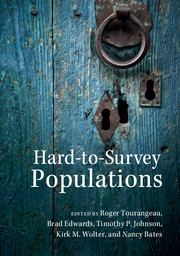Book contents
- Frontmatter
- Dedication
- Contents
- List of figures
- List of tables
- List of boxes
- List of contributors
- Preface
- Part I Introduction
- Part II Conducting surveys in difficult settings
- 6 Disaster research: surveying displaced populations
- 7 Conducting surveys in areas of armed conflict
- 8 Interviewing in disaster-affected areas: lessons learned from post-Katrina surveys of New Orleans residents
- 9 Reaching and enumerating homeless populations
- 10 “Where are our costumes?”: the All Ireland Traveller Health Study – our Geels 2007–2011
- Part III Conducting surveys with special populations
- Part IV Sampling strategies for the hard to survey
- Part V Data collection strategies for the hard to survey
- Index
- References
9 - Reaching and enumerating homeless populations
Published online by Cambridge University Press: 05 September 2014
- Frontmatter
- Dedication
- Contents
- List of figures
- List of tables
- List of boxes
- List of contributors
- Preface
- Part I Introduction
- Part II Conducting surveys in difficult settings
- 6 Disaster research: surveying displaced populations
- 7 Conducting surveys in areas of armed conflict
- 8 Interviewing in disaster-affected areas: lessons learned from post-Katrina surveys of New Orleans residents
- 9 Reaching and enumerating homeless populations
- 10 “Where are our costumes?”: the All Ireland Traveller Health Study – our Geels 2007–2011
- Part III Conducting surveys with special populations
- Part IV Sampling strategies for the hard to survey
- Part V Data collection strategies for the hard to survey
- Index
- References
Summary
Whether called roofless (India), sin techo (Latin America), itinérants (Quebec), furosha (Japan), or gamino (street child of Columbia), homeless individuals and families confront us with a failure to provide safe and permanent dwellings to meet our most basic human needs. In the United States, by the 1980s the homeless had migrated out of the skid rows and the Bowery of cities to become a visible presence in many neighborhoods of cities and suburbs. A major reason for the increase in homelessness was the great reduction of affordable housing, including the loss of 2.3 million units of low-income housing between 1973 and 1992 (Wagner & Gilman, 2012). A second reason was the retreat from a policy of financial assistance to single unemployed individuals, General Assistance (in some places called the “rent money”), in the 1980s as we moved from cash assistance to providing housing and food through homeless shelters and soup kitchens (Glasser & Bridgman, 1999). In addition, the stagnant and falling income of low-wage workers put housing out of reach for many workers (National Coalition for the Homeless, 2009).
As the US was confronting the visible homeless, policymakers, and the public wanted to know how many homeless individuals and families existed and who they were. The answer to these questions proved to be difficult. The numbers varied depending whether the count came from a census, surveys based on sampling, or administrative records such as shelter rosters.
- Type
- Chapter
- Information
- Hard-to-Survey Populations , pp. 180 - 200Publisher: Cambridge University PressPrint publication year: 2014
References
- 6
- Cited by

